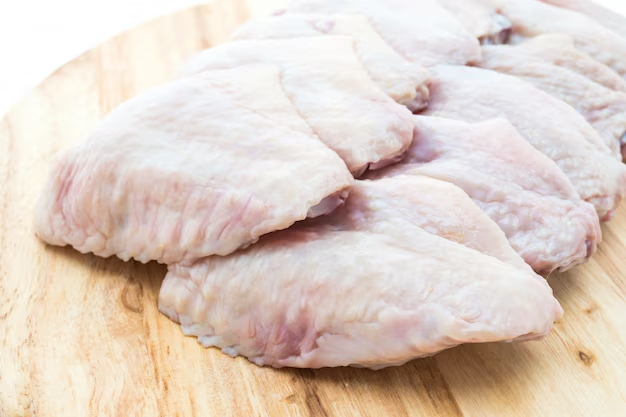How Long Can You Keep Fresh Chicken in the Refrigerator Without Worrying?
The moment you step into the bustling world of a supermarket or the cozy confines of your local butcher, fresh chicken stands as a prime choice for a myriad of delicious culinary creations. Yet, a pressing question lingers as you prepare to store this poultry staple in your kitchen: just how long does fresh chicken last in the refrigerator? Navigating the intricacies of food storage ensures both delectable meals and safe dining experiences for you and your loved ones. In this guide, we dive deep into chicken storage, offering clarity and useful insights to maintain quality and prevent spoilage.
🕑 Understanding Fresh Chicken's Shelf Life
Fresh chicken, while it may look appealing and smell inviting, is a perishable item that demands mindful storage. Typically, fresh raw chicken can be refrigerated for 1 to 2 days. This includes whole chicken, chicken breasts, thighs, wings, and other cuts. Adhering to this timeframe is crucial for maintaining flavor and safety.
Why Is Fresh Chicken's Shelf Life Limited?
Several factors contribute to how long fresh chicken can be safely stored:
- Moisture Content: Chicken is naturally moist, providing an ideal environment for bacterial growth if not stored correctly.
- Temperature Sensitivity: Unlike pantry-safe items, chicken demands cold temperature conditions — ideally, a constant 40°F (4°C) or below.
- Bacterial Growth: Pathogens like Salmonella and Campylobacter can thrive if chicken isn’t adequately refrigerated, necessitating prompt cooking after the suggested storage period.
🧊 Essential Chicken Storage Tips
How to Store Chicken Properly
Proper storage techniques are indispensable when extending chicken’s freshness in the refrigerator:
- Original Packaging: Keeping chicken in its original packaging maintains a protective barrier. If the packaging is compromised, consider wrapping the chicken tightly in plastic wrap or aluminum foil to minimize air exposure.
- Airtight Containers: Transfer chicken to airtight containers, preserving moisture and deterring odors from affecting other refrigerated items.
- Refrigerator Placement: Store chicken on a low shelf or in a dedicated meat drawer, reducing the risk of cross-contamination with other foods.
Freezing Chicken for Longer Preservation
While the refrigerator offers short-term storage solutions, freezing chicken is effective for long-term preservation:
- Pre-freeze Preparation: Before freezing, separate chicken into meal-sized portions, making it easier to thaw only the desired amount.
- Packaging for Freezing: Use freezer-safe bags or heavy-duty aluminum foil to securely wrap the chicken. Removing excess air prevents freezer burn.
- Label and Date: Clearly label your package with the type of chicken and the date it was frozen, helping to manage inventory and avoid wastage.
- Expected Freezer Shelf Life: When properly stored, chicken parts can remain frozen for up to 9 months, while whole chickens might last up to 1 year.
🔍 Identifying Spoiled Chicken: Look, Smell, Touch
Even with meticulous storage, chicken can spoil. Understanding the telltale signs saves you from unpleasant and risky dining experiences:
- Visual Cues: Discoloration, such as a grey or yellowish tint, is a strong indicator of spoilage. White fat streaks should remain a consistent color.
- Odor Check: Fresh chicken has a subtle aroma. If the chicken emits an acrid, sour, or ammonia-like smell, discard it immediately.
- Texture Test: Slimy or sticky surfaces are alarming signs, indicating bacterial proliferation.
What Risks Accompany Spoiled Chicken Consumption?
Consuming spoiled chicken can lead to foodborne illnesses with symptoms including:
- Nausea
- Vomiting
- Diarrhea
- Fever
Eating safely stored chicken is imperative to avoid such adverse health effects.
🐔 Cooking & Handling Tips for Fresh Chicken
Handling chicken with due diligence minimizes contamination risks throughout the preparation process.
Safe Handling Practices
- Sanitize: Wash hands thoroughly before and after handling chicken, using soap and warm water.
- Surface Cleanliness: Use a cutting board dedicated to raw proteins, cleaning it with hot, soapy water post-use.
- Avoiding Cross-Contamination: Use separate utensils for raw chicken and other ingredients, further preventing possible cross-contamination.
Cooking Chicken to Safe Temperatures
Cooking chicken to a safe internal temperature is not just about flavor but safety:
- Minimum Cooking Temperature: Ensure chicken reaches an internal temperature of at least 165°F (74°C) to kill harmful bacteria.
- Resting Time: Let cooked chicken rest for a few minutes after removal from the heat source, allowing juices to redistribute evenly.
💡 Chicken Cooking Methods and Their Impact on Shelf Life
Cooked chicken lasts longer than raw chicken in the refrigerator, staying fresh for 3 to 4 days. Popular cooking methods include:
- Roasting: Enhances natural flavors, providing a crisp outer layer and juicy interior.
- Grilling: Offers a charred, smoky flavor and is ideal for outdoor meals.
- Poaching: Yields tender meat and retains moisture by cooking chicken in simmering liquid.
📝 Practical Tips & Key Takeaways
Effortlessly extend chicken's shelf life while ensuring delicious, safe meals with these strategies:
- 🚫 Avoid Delays: Store chicken promptly after purchase, minimizing time at unsafe temperatures.
- 🚪 Organize Fridge: Designate specific places for meat to reduce cross-contamination risks.
- 🔍 Regular Checks: Ensure your refrigerator maintains a constant temperature with a reliable thermostat or external thermometer.
- 🥶 Freeze Smartly: For maximum usability, divide chicken into portions to streamline later meal prep.
Concluding Thought
Fresh chicken, when stored, cooked, and handled with care, promises not only delightful meals but peace of mind knowing you prioritize food safety. The journey from store to table involves considered actions aligning with freshness and health. Remember, staying informed and vigilant can make your kitchen experiences both safe and flavorful, providing scrumptious dishes to be enjoyed by all.
With these guidelines, you're equipped not only to maximize fresh chicken's potential but to impress with meals that are both delicious and secure. Enjoy your culinary adventures, knowing each choice protects and enhances the dining experience for yourself and those you cherish.
